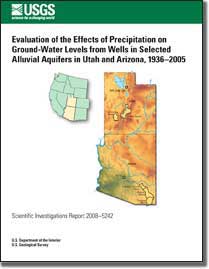 Abstract Abstract
Increased withdrawals from alluvial aquifers of the southwestern
United States during the last half-century have intensified the effects of drought on ground-water levels in valleys where withdrawal for irrigation is greatest. Furthermore, during wet periods, reduced withdrawals coupled with increased natural recharge cause rising ground-water levels. In order to manage water resources more effectively, analysis of ground-water levels under the influence of natural and anthropogenic stresses is useful.
This report evaluates the effects of precipitation patterns on ground-water levels in areas of Utah and Arizona that have experienced different amounts of ground-water withdrawal. This includes a comparison of water-level records from basins that are hydrogeologically and climatologically similar but have contrasting levels of ground-water development. Hydrologic data, including records of ground-water levels, basin-wide annual ground-water withdrawals, and precipitation were examined from two basins in Utah (Milford and central Sevier) and three in Arizona (Aravaipa Canyon, Willcox, and Douglas). Most water-level records examined in this study from basins experiencing substantial ground-water development (Milford, Douglas, and Willcox) showed strong trends of declining water levels. Other water-level records, generally from the less-developed basins (central Sevier and Aravaipa Canyon) exhibited trends of increasing water levels. These trends are likely the result of accumulating infiltration of unconsumed irrigation water.
Water-level records that had significant trends were detrended by subtraction of a low-order polynomial in an attempt to eliminate the variation in the water-level records that resulted from ground-water withdrawal or the application of water for irrigation. After detrending, water-level residuals were correlated with 2- to 10-year moving averages of annual precipitation from representative stations for the individual basins. The water-level residual time series for each well was matched with the 2- to 10-year moving average of annual precipitation with which it was best correlated and the results were compared across basins and hydrologic settings.
Analysis of water-level residuals and moving averages of annual precipitation indicate that ground-water levels in the Utah basins respond more slowly to precipitation patterns than those from the Arizona basins. This is attributed to the dominant mechanism of recharge that most directly influences the respective valley aquifers. Substantial recharge in the Utah basins likely originates as infiltrating snowmelt in the mountain block far from the valley aquifer, whereas mountain-front recharge and streambed infiltration of runoff are the dominant recharge mechanisms operating in the Arizona basins. It was determined that the fraction of water-level variation caused by local precipitation patterns becomes more difficult to resolve with increasing effects of ground-water pumping, especially from incomplete records. As the demand for ground water increases in the southwestern United States, long-term records of ground-water levels have the potential to provide valuable information about the precipitation-driven variation in water levels, which has implications to water management related to water availability.
|
Part or all of this report is presented in Portable Document Format (PDF); the latest version of Adobe Reader or similar software is required to view it. Download the latest version of Adobe Reader, free of charge. |